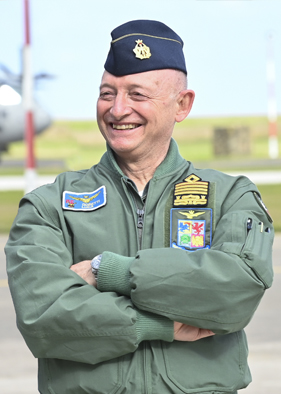May 2023, Year XV, no. 5
Luca Goretti
The Flying Aces Turn 100
“From 1923 to the present, the men, the planes, the organisation have all changed, but the spirit inspiring and guiding the men and women who don the light blue Air Force uniform has remained the same.”
Telos: One hundred years of history within history. What milestones in your past would you like to recall?
Luca Goretti: From 1923 to the present, the men, the planes, the organisation have all changed, but the spirit inspiring and guiding the men and women who don the light blue Air Force uniform has remained the same. In these 100 years we have operated with the utmost commitment, dedication and passion, always offering our invaluable skills to the community and the Institutions, which is what has made us what we are today: a dynamic Armed Force that is useful to the Country and has a strong propensity for technological innovation.
In my opinion, two salient moments, among the many that characterise our past and orient our future, could be Operation Desert Storm and the delivery of the first F35. The first one dates back to 1990 and marked an important operational evolution.
Forty-five years after World War II, the Italian Armed Forces, unfortunately, were involved in a conflict. Thanks to the use of the Tornado aircraft, the Italian Air Force had to face a new trial by fire with Operation Locusta.
Instead, the second moment marked an evolution in Combat Service Support and of the ‘direct logistic support’ [Ed.'s note to the mobile operating units] when in 2016 the entire Air Force took its first step toward the 5th generation: Thanks to a concerted effort, the first F35 assigned to the Air Force and assembled in the FACO in Cameri undertook an ocean transfer flight to reach the Patuxent River American base in Maryland.
The AL1, the name of that first F35A aircraft, due to the in-flight fuelling capacity offered by our KC767A tanker and the support of aircrafts EFA and C-130J, reached its destination surpassing the previous records set by the US for the longest continuous flight. I had the privilege of being there on 5 February 2016 in Patuxent River to welcome our first F35A with license number 32-01. It was the beginning of an epoch-making challenge.
What are the outlook and the challenges for the next 100 years?
Aircraft development has never stopped. Actually, if we look into the immediate future, there will be a push for 6th generation planes until they dominate aerospace. It is enough to think about the huge steps forward we have taken in recent decades with 4th generation aircraft: first, with the Eurofighters, which are the backbone of our air defence; and then the F35s, omni-role aircraft that ushered us into a new dimension: extremely stealthy, with cutting-edge sensors and long-range capabilities, technological features that allow us to continue our vital contribution to the security and defence of the Country.
Technological challenge is indeed a new reality, created by modern operational scenarios with asymmetrical threats that are in constant flux and no longer limited to a single operative environment.
The future of Air Power will be complex and made up of different systems, piloted and non-piloted, that are perfectly integrated and interconnected. The concept of ‘multidomain’, connectivity and of systems within systems are key points for future aerospace platforms. The Global Combat Air Programme (GCAP), 6th generation aircraft, along with drones, command and control platforms, satellites and ground stations will be the links in an information chain that will ensure constant analysis and action.
Our vision is to maintain a markedly technological Air Force that is increasingly streamlined, agile, responsive, capable and useful to the Country. We are exploring new technological and scientific horizons and paying greater attention also to the security of and access to space and cyberspace, so we can use enabling technologies that are more and more innovative and that allow us to look to the future, to tomorrow, and be ready to remain relevant in the face of changing risks and threats.
The Arma Azzurra [Blue Troops] has been present in international missions since the sixties and recently has been especially and extraordinarily involved at the margins of the Russia-Ukraine conflict. What tasks and functions are you all engaged in?
Since the early ‘60s, the Air Force has been operating in international missions: from its involvement in Africa under the UN and then with its operations during the Gulf War, in Kuwait, in the Balkans, in Eritrea. After the global turmoil of 2001, our Defence and Air Force have contributed to international security by also operating in Afghanistan, Iraq and Libya.
A past of full of commitment for the benefit of the community and international security. Today we remain committed to this by actively supporting, from the very first day, the defence of the eastern flank of the coalition and by taking part in NATO air-policing operations. In the last two years, we have supported Lithuania, Estonia, Iceland, Poland and Romania.
Just to give you an idea of our 2022 engagement, we did over 170 scrambles to intercept enemy aircraft and logged 550 flight hours between real activities and training. We began 2023 in Romania where our Eurofighters will be stationed at least until the end of the summer, then our work for NATO will continue in Lithuania until the end of the year. Our efforts are constant and continuous with the participation of Air Force women and men of the past, present and future intent on defending the skies of the Alliance.
However, this will not distract us from our future: space. The role of space and our role in it is increasing in terms of political and economic policy and, consequently, some aspects of international and national security and defence. The Air Force is looking with particular interest at the areas between 20 and 100 km in height, the natural continuation of the ‘air space’ it operates in on a daily basis. This area will be made accessible by new technologies and will be the ‘door’ to the transition from air to space domination.
You’ve had a very long career, with a wide range of experiences, in Italy and abroad. And not only military experience. Which of the many do you most fondly remember and why?
Honestly, there is no single episode that comes to mind among all those I’ve experienced. My career has given me great operational and technological satisfaction, but most of all, human satisfaction. I have met special woman and men, in coveralls, head to toe with grease but full of passion for their work. I have had happy moments with my colleagues from Zodiac 3° and the 156th Group: two second families that are still united.
Unfortunately, I have had difficult and even some sad moments recently. But I still find one thing gratifying: the smile of a colleague, whether they are an officer, an underling, a navigator or any other speciality. It fulfils me, motivates me, allows me to look ahead with trust.
Like the smile of a colleague of mine who, crestfallen after his career development didn’t lead to the goals he had hoped for, asked me if he could salute the Air Force War Flag on the day of our 100th birthday in Piazza del Popolo in Rome. Just then, someone walking past saw him in his uniform, patted him on the back and thanked him for what he does. His smile, and the “traditional” tear of emotion in saluting our Tricolour Flag, I’ll never forget it. Right then, I was glad I could offer him an unforgettable opportunity.
Marco Sonsini
Editorial
Our May guest for PRIMOPIANOSCALAc truly is a guest of honour: Air Squadron General Luca Goretti, Chief of Staff for the Italian Air Force. The Blue Troops! This year they celebrate the 100-year anniversary of the founding of the Air Force and we have borrowed some of the words General Goretti shared during the celebration, attended by the President of the Italian Republic Sergio Mattarella and highest representatives of the government and of the Armed Forces.
“On 28 March 1923 the Royal Independent Air Force was born, with its own uniform, rank insignia and specialities.” On that occasion, Mattarella decorated the Air Force War Flag with the honorific Knight of the Military Order of Italy for its longstanding commitment to the “skies of Italy and the world”. Why do we want to stress this? Because the War Flag, according to Goretti, is: “The symbol of a story made up of values, passion, attachment to the institutions and custodians of the memories of those who came before us and took part in the greater Air Force.” These certainly are not empty words, they are charged with pathos and emotion, that may seem outdated, but instead, continue to be the mightiest glue rendering each of the armed forced a strong, united bloc, capable of taking on any situation, challenge or difficulty… In our interview, Goretti underlines the importance, yes, of the past, but the present and future are also even more central to his vision as Chief of Staff. The present, made up of extraordinary operational efforts in an “extremely variable, uncertain, unstable, sometimes critical geostrategic context like the one we are experiencing in the Russia-Ukraine war,” according to a hearing held at the Senate before the Senate Foreign Affairs and Defence Committee last March 23 on the programmatic lines of his mandate. Goretti also describes the strategic role of technology and data for air defence, the importance of the agreement on the Global Combat Air Programme (GCAP), drones, satellites… I mean, we won’t just be seeing our Air Force in the skies, we’ll also be seeing them in space, or at least in “the areas between 20 and 100 km in height, the natural continuation of the ‘air space’ it operates in on a daily basis.” I confess I am rather ignorant of this matter, and it was thanks to this interview that I realised that astronauts like Roberto Vittori (now the Head of the Space Main Office of the Air Force), Maurizio Cheli, Samantha Cristoforetti and Luca Parmitano, were or still are, first and foremost, Air Force officers. But actually, Goretti doesn’t talk about this type of experience, he talks about the need for leadership in a context he feels to be a natural continuation of the domain where the Air Force is engaged every day. It is strategically relevant that Italy equips itself with the right tools to operate in aerospace freely while also defending its interests in ever-more-crowded space.
And who can do this better than the Air Force? Space and Aerospace are a continuum where it can exertits skills. Aerospace is an essential resource for our Country and it must be cultivated. It is a fundamental boon for the economy, employment, technology and society that must be valued, preserved, protected and defended.
The interview with commander Goretti gives us an exciting peek into what his Air Force has done, what it is doing and what it will do. However, it is also fundamentally steeped in a more important, lesser-known quality, one that marks the difference between a general and a commander of men: humanity, interest, true, tangible closeness to his men, whether they are an “officer, an underling, a navigator or any other speciality.”
On the 2023 covers of PRIMOPIANOSCALAc, we use the faces of our guests to create something similar to museum merchandise. Every month we personalise an item with the black and white face of our guest. This way, a t-shirt, magnet or shopper becomes a memory, an experience, a symbol. Our guests become icons, just like museum pieces such as Da Vinci’s Vitruvian Man, Van Gogh’s sunflowers, Michelangelo’s The Creation of Adam in the Sistine Chapel… For Goretti, we have chosen a pilot’s backpack to represent his work and his Air Force. All we can do is thank him. For everything.
Mariella Palazzolo

Air Squadron General Luca Goretti has been the Chief of Staff of the Italian Air Force since 31 October 2021. His long career began at the Air Force Academy with the “Zodiac 3°” Course. When he got out of the academy, he first got a Degree in Aeronautics from the University of Naples in 1984, then in Political Science at the University of Trieste in 2005.
In 1985 he got his Military Pilot’s license from the Euro-NATO Joint Jet Pilot Training Programme (ENJJPT) at Sheppard Air Force Base in Texas (USA) on a T-38 jet. At the end of the pre-operative course, he was assigned to the 156th group of the 36th fleet in Gioia del Colle (BA) as a pilot in the 383a Squadron. As commander of this squadron, he took part in the initial phases of the Persian Gulf Operations.
Subsequently, from 1995 to 1998, first as the Sectional Head of Operations and then as the Commander of the 156th group, he took part in flight operations connected to the Balkan crisis as part of the NATO operations in the “Former Yugoslavia”.
After countless experiences in NATO and after being promoted to Colonel, Goretti served until June 2003 as head of the 1st Office of the Inspectorate for Flight Safety and Director of Rivista SV. In June 2003 he was assigned to the 32nd fleet as Superior Officer reporting to the Fleet Commander. He assumed command of this fleet in July 2003 and served until September 2005.
Since then, he has served as Vice Head of Staff to the Minister of Defence and then as the Attaché for Defence and Defence Cooperation for the Italian Embassy in Washington D.C. (USA). During this time, he also represented Italy as a Permanent Observer at the “Inter-American Executive Committee” with offices in Washington D.C. From February 2019 to 30 October 2021 he served as Deputy Chief of Staff for the Air Force. He has around 3000 flight hours under his belt, more of 2000 of which were on a Tornado and he has a license to fly the following aircraft: SF-260, T37, T38, G91T, PA200, AMX-T, AMX, NH500, HH139.
What is his passion? Flying, obviously! “I still fly the Tornado and it still feels like the first time. For us, being in a plane is like being home. A pilot has to bring his passion onto a mechanical means of transport: this is the essence of being a pilot.”
Gen. S.A. Goretti was born in Rome on May 15, 1962 and is married to Lorena.
Marco Sonsini







SocialTelos